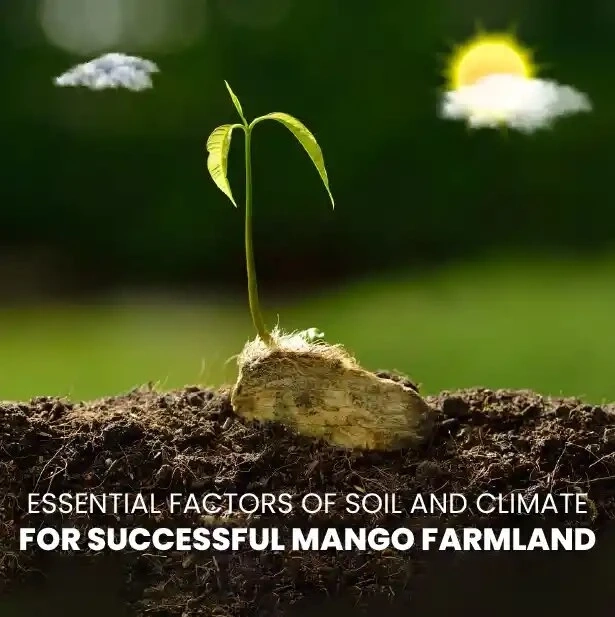Mangoes, which are sometimes called the "king of fruits," are loved all over the world because they taste great and are good for you. Mango farming can be a good way to make money and feel good about yourself. But growing mangoes successfully depends on knowing and making the best use of important soil and temperature factors. We will talk about the most important things that make a mango farmland healthy in this piece.
Soil Requirements for Mango Farmland
Soil Type:
Well-Drained Soil: Mangoes grow on well-drained ground. Appropriate is alluvial, or sandy loam, soil. Other fungal diseases and root rot can result from poorly drained soils. Organic matter or sand could have to be included to improve drainage in heavy clay soil.
Soil Depth: The extensive root system of mango trees depends on a minimum depth of 2–2.5 metres. Shallow soils restrict the absorption of nutrients and root development. Better anchorage for trees, which is essential for their long-term stability and output, comes from deep soils as well.
Soil pH:
Mango trees like somewhat acidic to neutral soil with a pH between 5.5 and 7.5. Extremely acidic or alkaline soil can therefore affect nutrient absorption, limiting tree health and fruit quality. Maintaining the ideal pH balance can be helped by routine pH testing and suitable adjustments like lime for acidic soils or sulphur for alkaline soils.
Nutrient Content:
Organic Matter: Organic matter-rich soils thus enhance soil structure and encourage good root development. Including well-rotted manure or compost will help to raise soil fertility. Additionally helpful during dry times is the retention of moisture made possible by organic materials.
Essential Nutrients: Make sure that the soil has suitable levels of nitrogen, phosphorus, potassium, calcium, magnesium, and micronutrients, including iron and zinc. Frequent soil testing can help assess nutrient content and direct fertilisation choices. Any one of these nutrients can have deficiencies that cause low yields, poor growth, and lower fruit quality.
Soil Texture and Structure:
The good structure and texture of the soil enable appropriate water flow and root penetration. Desired are loamy soils with enough aeration. Steer clear of compacted soils; these might restrict water absorption and root development. By including organic matter and maintaining soil health via techniques like no-till farming, soil structure can be enhanced.
Climate Requirements for Mango Farmland
Temperature:
Mangoes develop in tropical and subtropical conditions. Between 24°C and 30°C (75°F and 86°F) is the perfect temperature. While prolonged contact with temperatures above 40 °C (104 °F) can stress plants and lower fruit quality, temperatures below 10 °C (50 °F) can damage young trees. Growers in places with regular frost could have to use preventative strategies, including irrigation or froscloths, to stop damage.
Rainfall:
Mango trees need between 750 and 2500 mm of annual moderate rainfall. Still, timing of the downpour is crucial. Strong rain all during the flowering and fruiting season could cause fruit splitting and blossom drop. A dry period during flowering and fruit development is hence ideal. More irrigation could be needed in areas with irregular rainfall to keep appropriate moisture levels.
Humidity:
Particularly in the blossoming stage, high humidity can encourage fungal infections such as powdery mildew and anthracnose. For a strong fruit set, a dry environment during blooming is best. Choosing disease-resistant mango varieties and implementing good orchard management can help to lower the risk of fungal diseases in humid conditions.
Sunlight:
Mango trees provide excellent mangoes, but only with enough sunlight. Make sure the trees get a minimum of eight to ten hours of direct sunlight every day. Appropriate tree distance can minimise shading and enhance sunlight exposure. Dense planting can intensify light competition, therefore reducing general productivity and fruit quality.
Wind Protection:
While mild winds could help pollinate, too strong winds might damage fruits and plants. Create windbreaks or designate areas of protection to shield mango trees from strong gusts. Natural (rows of tall trees) or manufactured (windbreak fences) windbreaks are possible.
Conclusion
Effective mango farmland requires a comprehensive knowledge of the important soil and climate variables since it combines science with art. Maximising these conditions can help you guarantee top-notch mangos, good development, and high yields. Whether your experience level is that of a first-time producer or a seasoned farmer, paying close attention to these key elements can help you create profitable and successful mango farming. Your mango acreage will flourish and yield plenty for many years to come with appropriate soil preparation, temperature control, and consistent attention.



